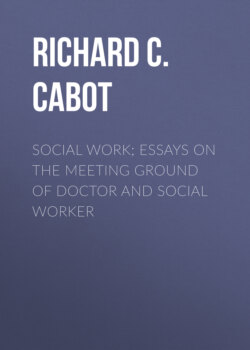Читать книгу Social Work; Essays on the Meeting Ground of Doctor and Social Worker - Richard C. Cabot - Страница 8
На сайте Литреса книга снята с продажи.
IV
ОглавлениеTable of Contents
I must speak at this point of another great French contribution towards the occupation which in its fully developed state we now call social work. I mean that which at present receives ordinarily the name of the "Œuvre Grancher." Grancher proceeded upon the same sound bacteriological foundations which guided Calmette. Since children are especially susceptible to tuberculous infection (though they rarely show alarming signs of it till later years), he planned the separation of children from the neighborhood of tuberculous parents or other tuberculous persons as an essential measure for preventing contagion. I am not concerned now with the enormous benefit derived by the forces struggling against tuberculosis from this insight of Grancher's, nor with the part which it has played in such success as that fight has already attained in the United States and elsewhere. What interests me particularly in connection with the topic of this book, is that the procedures suggested by Grancher led the physicians who came in contact with the tuberculous individual in a dispensary to extend their interest to other persons who did not present themselves at the dispensary as patients. It is not obvious at first sight how great a transforming principle is thereby introduced. Hitherto the doctor had been passive in his activities at the dispensary. He had concerned himself with such patients as chanced to appear there. He had never taken the active or aggressive attitude, searching for possible patients among those who had made no attempt to avail themselves of his services. Now he goes to find patients.
This is an epoch-making change. The physician becomes henceforth not merely a person who stands ready to treat disease when the accidental and incalculable forces of custom, hearsay, and natural propinquity bring the patient to him. He becomes now a person who actively wars against disease, who searches it out wherever it may be found. Thus he approaches for the first time the possibility of truly preventive action, the possibility of killing disease in its infancy or preventing its birth. For it is well known that preventive action in relation to disease is well-nigh impossible if we are forced or accustomed to wait until the disease has made such progress that the patient himself is aware of it and forced by its ravages to ask medical aid. Ordinarily the patient seeks the physician only when he has broken down. From the point of view of public health and public good, this is grievously late, far too late. It is as if one inspected an elevator only after it had fallen and killed or maimed its passengers, instead of inspecting it at regular intervals so as to prevent its breaking down.
In this series of aggressive steps in the campaign against tuberculosis whereby one seeks out possibly infected children, brings them to a dispensary for examination, and separates them from their infected parents or house-mates, the social worker is the all-important executive. She finds the children, brings them or has them brought to the dispensary, and sees that financial aid or other assistance is given so as to carry out the isolation demanded by our bacteriological knowledge of the disease.
